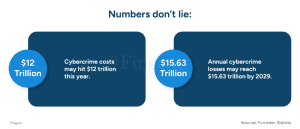Top Technologies Used to Develop Mobile App
Startups face unique challenges that only tailored software can solve. Off-the-shelf software often fails to address their specific needs. That’s why understanding the latest custom software development trends has become indispensable for startups who want to remain competitive and future-ready in the modern world.
Startups operate in dynamic environments, requiring agility and precision. Custom software development offers several advantages:
Startups that see software as a cost miss the bigger picture. The most successful companies – Airbnb, Shopify, Stripe – built their own. They saw software as a strategic tool. Investing in custom software drives growth and success.
Most people think of security as defense, but it’s more than that. Strong cybersecurity builds trust plus attracts customers and investors. Custom software lets startups add tailored security features, protecting data and boosting confidence.

Consider this:
Imagine two fintech startups. One uses off-the-shelf banking software that follows industry standards. The other develops a custom solution with zero-trust architecture and AI-powered fraud detection. Who do you think a cautious investor or enterprise partner will trust more?
Startups that invest in security early don’t just avoid breaches—they attract premium customers and investors who prioritize security.
Custom software’s ability to scale with a startup’s growth is a significant advantage. Tailored solutions can adapt to increasing user bases, data loads, and feature expansions without the limitations often encountered with off-the-shelf software.
Case Studies:
Uber: Developed a custom backend capable of handling millions of real-time requests, facilitating seamless scalability.
Zomato: Utilized custom software to manage rapid growth and a vast amount of user interactions efficiently.
These examples illustrate how custom software enables startups to pivot and expand without being constrained by technological limitations.
Here is the takeaway:
Think about how startups like Zomato and Uber grew. If they had relied on rigid, generic software, their platforms would have crumbled under demand. Instead, they built custom backends that dynamically adjusted to millions of requests in real time.
A startup that builds scalable software from day one can pivot and expand effortlessly—rather than being held hostage by technological limitations.
Many startups rush into SaaS solutions because they’re fast and convenient. But here’s the catch—SaaS platforms own your data, dictate your pricing, and limit your flexibility.
With custom software, you’re not at the mercy of third-party providers who can:
How are the latest trends in software development helpful for you?
Let’s say you run a health-tech startup that uses a third-party CRM. One day, the CRM provider decided to restrict access to patient analytics due to a new pricing model. You either pay up or lose essential data. A startup using custom-built CRM software never faces this issue—it owns its tech stack outright.
Startups with full ownership of their technology have the power to innovate on their own terms without being shackled by external vendors.
When every competitor is using the same software, differentiation becomes impossible. Custom software is not just about functionality—it’s about building an identity.
Consider this:
Think of Apple’s iOS vs. Android. The reason iOS users stay loyal isn’t just because of hardware—it’s because of the seamless, unique software experience. Startups that invest in custom software create their own ecosystems, ensuring users stay engaged.
When you control your software, you control your brand experience. And in a market where customer loyalty is fragile, that control is priceless.
The choice is yours. Do you want to be a leader or just another startup using the same tools as everyone else?
The tech landscape moves faster than a startup founder after their third espresso. What’s cutting-edge today is outdated tomorrow. If your software strategy doesn’t evolve, your business risks becoming extinct.
To stay ahead, here are the latest trends in software development that will dominate 2025—plus real-world examples of companies making them work.
Software development trends come and go, but one thing remains constant – businesses that adapt thrive, and those that don’t… Well, let’s just say we don’t remember the names of failed startups.
At Fingent, we focus on tailored software solutions that resonate with these developing trends. Whether you’re seeking AI-powered automation, cloud-based applications, blockchain integration, or security-focused software, we have solutions for you.
Looking to secure your business’s future? Let’s create something remarkable together.








Every small business requires an array of software to run its operations smoothly and successfully. When starting a new business, it may seem like your off-the-shelf software would suffice all your needs. As your business grows, your business management software should scale to meet your team’s evolving needs, boost the efficiency of your workflows, and be flexible to support new use cases. Custom software or a software application tailor-made to address your specific business requirements helps improve your market competency and realize ROI at a faster pace.
How will you determine if custom software is the right fit for your small business?
Read on this post to learn more about custom software for small businesses.
Read more: 5 Reasons Why Custom Software is Important for Your Business
The classic “build vs. buy” decision is a pertinent question that every small business faces when addressing their software needs. Considering the cost, time, energy, and resources dedicated to custom software development, many SMEs adopt packaged software in a haste. Look out for these warning signs before deciding whether to build or buy.
Find out if your employees are satisfied with your existing off-the-shelf software. Do they still stick to old-school tricks or find manual methods faster and more convenient? Are your employees forced to discover alternative workarounds to use the software? Do they still rely on spreadsheets and how-to guides for using the software? All these signs indicate that your off-the-shelf software lacks employee approval and can fail your business eventually.
Rolling out enterprise-wide canned software that commands an advanced level of technical expertise will inflict more harm. It will complicate the processes for your employees and incur heavy training costs. Complex shelf software will fail the very purpose of technological innovation, that is, to simplify human efforts. If only less than 20% of your employees find the software workable, it’s better to build a customized solution.
View Infographic: Custom Software vs. Commercial Off-the-shelf Solutions
Is your software forcing your employees to spend their valuable time on routine activities that don’t require human thought and creativity? If your software isn’t allowing you to leverage the potential of automation, it can minimize your employees’ productivity and workplace efficiency. Automation of mundane tasks with minimal or adequate supervision is a must for small business growth and success.
Adapting a rigid off-the-shelf solution for your small business needs requires you to subscribe to third-party apps and pay multiple licensing fees. Most biz owners end up paying full price for unwanted features. Some companies would want to integrate estranged business applications to increase the usability of their shelf software. All these challenges lead to increased software spending.
Your business data comes from multiple sources such as your website, emails, social profiles, chat, and conversation histories, helpdesk, and so on. How far is your canned software allowing you to make use of this data? Are your decisions driven by live data? If your dashboards aren’t getting updated in real-time and reports throw only past information, it’s time to consider custom software. Integrating multiple business systems and exporting all the useful data insights onto a centralized, user-friendly platform in real-time will empower small businesses to make rightful decisions.
Watch Video: Why Your Business Requires Custom Software
Small business competition has intensified in recent years. Thanks to the increasing democratization of digital innovation! Access to technological advancements is no longer limited to large enterprises. With a custom-built software, your small business can stay relevant and competitive.
Custom software development guarantees 100% alignment with specific business needs. You can rest assured that no crucial operations are left unsupported and there aren’t any wasted features. Share your unique requirements with a trusted custom software development company like Fingent and get exactly the features you would require on a long-term.
Ready-to-use software is highly vulnerable to cyberattacks due to the widespread availability of code and proliferation of users. Owning custom code places your small business under lock and key and keeps your sensitive information hack-proof. Customized solutions offer built-in security with a specialized approach to development. Better compliance and data governance improves your organization’s reputation and trust.
Attaining profitability amid stiff competition needs your employees to put in their best performance. Experienced custom software companies like Fingent can help you identify the workflows or business functions that can be improved with the right technology. This makes your business more efficient and maximizes the productivity of your employees.
Improved business efficiency transforms to lower operational costs. Technologies like automation enable your employees to complete more tasks in less time, without feeling monotonous. Custom software actually costs lesser than off-the-shelf solutions, considering the extra dollars you would spend on subscriptions, licenses, third-party integrations, software upgrades and maintenance, and other overheads required to make the shelf software workable.
Read more: Know What’s Driving Custom Software Development Costs in 2022
Modern business might come to a standstill if technology stops working. A typical readymade software provider puts you into a long wait with back-to-back support tickets and repeated calls, whereas a dedicated custom software development partner offers access to a direct line of technical support to resolve your issues immediately.
Read more: The Dos and Don’ts of Custom Software Development
Hiring the services of an experienced custom software development agency will help you focus on developing a sustainable business model. How can you identify the right software development partner for your small business? Here’re a few tips we recommend:
Selecting the right custom software development partner is a meticulous job. Check out our earlier post covering these and more crucial tips in detail.
Also read: How to Choose the Right Custom Software Development Firm
Over the past two decades, Fingent has been serving as a reliable and capable tech partner for many leading global brands, including Fortune 500 companies. With an impeccable track record as a successful custom software development partner, we’ve helped improve cash flow and business efficiency for many clients. If hiring in-house developers is costing you a fortune, extend your development team with our dedicated talent pool at reasonable rates.
Read more: Top Benefits of Outsourcing Software Development Services
We’re in track of the latest tech development trends and help our clients explore new and emerging tech such as Augmented Reality (AR), Virtual Reality (VR), Internet of Things (IoT), 3D Web Configurator, Robotic Process Automation (RPA), Artificial Intelligence (AI), and so on. If you’re an aspiring small biz owner trying to make the most of technology without burning a deep hole in your pocket, connect with our team and get started. Let’s help you build scalable and robust small business software.




Every small business requires an array of software to run its operations smoothly and successfully. When starting a new business, it may seem like your off-the-shelf software would suffice all your needs. As your business grows, your business management software should scale to meet your team’s evolving needs, boost the efficiency of your workflows, and be flexible to support new use cases. Custom software or a software application tailor-made to address your specific business requirements helps improve your market competency and realize ROI at a faster pace.
How will you determine if custom software is the right fit for your small business?
Read on this post to learn more about custom software for small businesses.
Read more: 5 Reasons Why Custom Software is Important for Your Business
The classic “build vs. buy” decision is a pertinent question that every small business faces when addressing their software needs. Considering the cost, time, energy, and resources dedicated to custom software development, many SMEs adopt packaged software in a haste. Look out for these warning signs before deciding whether to build or buy.
Find out if your employees are satisfied with your existing off-the-shelf software. Do they still stick to old-school tricks or find manual methods faster and more convenient? Are your employees forced to discover alternative workarounds to use the software? Do they still rely on spreadsheets and how-to guides for using the software? All these signs indicate that your off-the-shelf software lacks employee approval and can fail your business eventually.
Rolling out enterprise-wide canned software that commands an advanced level of technical expertise will inflict more harm. It will complicate the processes for your employees and incur heavy training costs. Complex shelf software will fail the very purpose of technological innovation, that is, to simplify human efforts. If only less than 20% of your employees find the software workable, it’s better to build a customized solution.
View Infographic: Custom Software vs. Commercial Off-the-shelf Solutions
Is your software forcing your employees to spend their valuable time on routine activities that don’t require human thought and creativity? If your software isn’t allowing you to leverage the potential of automation, it can minimize your employees’ productivity and workplace efficiency. Automation of mundane tasks with minimal or adequate supervision is a must for small business growth and success.
Adapting a rigid off-the-shelf solution for your small business needs requires you to subscribe to third-party apps and pay multiple licensing fees. Most biz owners end up paying full price for unwanted features. Some companies would want to integrate estranged business applications to increase the usability of their shelf software. All these challenges lead to increased software spending.
Your business data comes from multiple sources such as your website, emails, social profiles, chat, and conversation histories, helpdesk, and so on. How far is your canned software allowing you to make use of this data? Are your decisions driven by live data? If your dashboards aren’t getting updated in real-time and reports throw only past information, it’s time to consider custom software. Integrating multiple business systems and exporting all the useful data insights onto a centralized, user-friendly platform in real-time will empower small businesses to make rightful decisions.
Watch Video: Why Your Business Requires Custom Software
Small business competition has intensified in recent years. Thanks to the increasing democratization of digital innovation! Access to technological advancements is no longer limited to large enterprises. With a custom-built software, your small business can stay relevant and competitive.
Custom software development guarantees 100% alignment with specific business needs. You can rest assured that no crucial operations are left unsupported and there aren’t any wasted features. Share your unique requirements with a trusted custom software development company like Fingent and get exactly the features you would require on a long-term.
Ready-to-use software is highly vulnerable to cyberattacks due to the widespread availability of code and proliferation of users. Owning custom code places your small business under lock and key and keeps your sensitive information hack-proof. Customized solutions offer built-in security with a specialized approach to development. Better compliance and data governance improves your organization’s reputation and trust.
Attaining profitability amid stiff competition needs your employees to put in their best performance. Experienced custom software companies like Fingent can help you identify the workflows or business functions that can be improved with the right technology. This makes your business more efficient and maximizes the productivity of your employees.
Improved business efficiency transforms to lower operational costs. Technologies like automation enable your employees to complete more tasks in less time, without feeling monotonous. Custom software actually costs lesser than off-the-shelf solutions, considering the extra dollars you would spend on subscriptions, licenses, third-party integrations, software upgrades and maintenance, and other overheads required to make the shelf software workable.
Read more: Know What’s Driving Custom Software Development Costs in 2022
Modern business might come to a standstill if technology stops working. A typical readymade software provider puts you into a long wait with back-to-back support tickets and repeated calls, whereas a dedicated custom software development partner offers access to a direct line of technical support to resolve your issues immediately.
Read more: The Dos and Don’ts of Custom Software Development
Hiring the services of an experienced custom software development agency will help you focus on developing a sustainable business model. How can you identify the right software development partner for your small business? Here’re a few tips we recommend:
Selecting the right custom software development partner is a meticulous job. Check out our earlier post covering these and more crucial tips in detail.
Also read: How to Choose the Right Custom Software Development Firm
Over the past two decades, Fingent has been serving as a reliable and capable tech partner for many leading global brands, including Fortune 500 companies. With an impeccable track record as a successful custom software development partner, we’ve helped improve cash flow and business efficiency for many clients. If hiring in-house developers is costing you a fortune, extend your development team with our dedicated talent pool at reasonable rates.
Read more: Top Benefits of Outsourcing Software Development Services
We’re in track of the latest tech development trends and help our clients explore new and emerging tech such as Augmented Reality (AR), Virtual Reality (VR), Internet of Things (IoT), 3D Web Configurator, Robotic Process Automation (RPA), Artificial Intelligence (AI), and so on. If you’re an aspiring small biz owner trying to make the most of technology without burning a deep hole in your pocket, connect with our team and get started. Let’s help you build scalable and robust small business software.




A decade ago, web pages were mostly static, with a few images and videos thrown in here and there. In 2005, however, thanks to Ajax, it made it possible to create better, faster, and more interactive web applications.
In 2021, though web application development has reached its peak of fame, web apps have become so common that they often go unnoticed. With a reputed web application development partner like Fingent, you can develop intuitive and custom web applications that simplify your day-to-day operations.
Read more: Fingent Ranked as India’s Top Software Developer for 2021
Web apps help integrate the tailored experience of native apps with easy access on a website browser from any device. LinkedIn, Basecamp, MailChimp, or even Facebook, all have web apps that provide immersive and tailored experiences like the native apps directly from the browser. That is why web application development is gaining a lot of popularity in almost all industries, including banking, eCommerce, education, healthcare, and more.
Also known as a web app, a web application is nothing but a computer program that uses a web browser to perform a specific function. Contact forms, for example, are web apps present on many websites.
As a web application is a client-server program, it has a client-side and a server-side. Here, the client refers to the program the individual uses to run the application. It is a part of the client-server environment where many computers share data. A typical example of a web application is the database. Here, the user enters data through the client-side (front-end), while the server-side (back-end) of the application stores and processes the information.
Both enterprises and individuals develop web applications to fulfill different purposes.
Case Study: How we built Ambit AI, a light-touch AI-powered web application for processing workers’ compensation claims. Download Now!
Web application development refers to the process of using client-side and server-side programming to develop an application that is made accessible over the web browser.
In the initial phase of the web application development process, the developer tries to find a solution to a specific problem and then designs the web app by choosing the appropriate development framework. Later, the developer tests and deploys the web app.
Read more: The 101 Guide to Web Application Development
While web apps and mobile apps are similar in many ways, both are different in many ways.
Mobile apps are made exclusively for mobile gadgets and are suitable for Android, iOS, and Cross-platform operating systems. Usually, mobile apps are mobile-first, meaning they work effectively on smartphones, tablets, or other handheld mobile devices. Most mobile apps work offline too. Examples include Google Maps, Amazon Kindle, Uber, etc. On the other hand, web apps function only when you have internet connectivity. A web app functions in real-time in a web browser with CPU resources. As long as you have adequate internal storage, you can download a mobile app from an app store or play store.
Read more: How are Mobile Apps Different from Websites
Typically, web applications are classified into three categories based on the tools and technologies it uses.
Client-side refers to everything the user sees at the end-user side, such as text, images, videos, forms, and the other UI. Client-side web applications are written using HTML, CSS, and JavaScript, and they work in a web browser. Angular js, Vue js, Ember js, Backbone js, Node js, etc., are some of the popular JavaScript libraries used for front-end development.
You can consider client-side web app building when you don’t need to preserve the user information for more than one session. It is perfect for easy games or image editors. Google Earth is a leading example of a client-side web application.
These are web apps that can be coded in several programming languages such as Python, C+, Ruby, PHP, etc. If you develop an app with just the server-side, then the outcome of any changes in the form submission, sections, and data updates will create a new HTML file and cause the web page to reload.
Server-side programming is beneficial if you want your web application to deliver information tailored for individual users. For instance, e-commerce applications like Amazon use server-side programming to create product search results, offer product suggestions based on past buying habits, enhance user experience, and simplify the purchasing process.
Single-page applications are designed to work in a browser and do not require reloading while in use. Most of our daily apps, such as Facebook, Twitter, Google Drive, Gmail, etc., are single-page apps. Single-page web applications offer an unmatched user experience as the user doesn’t have to wait for page reloads. Single-page applications are highly responsive to user queries as they do not depend heavily on client-server communication.
Read more: A Detailed Guide to Types of Software Applications
The following web development technologies enable you to create a high-performing, fast, and advanced web application.
Due to its simplicity and multifunctionality, MySQL is one of the most preferred databases utilized for web application development. Other popular database technologies include Oracle Database, PostgreSQL, Microsoft SQL Server, Microsoft Access, MongoDB, and RavenDB.
To develop the client-side of an app that the users interact with, you can choose highly efficient front-end JavaScript frameworks such as:
The above list features only some of the leading JavaScript frameworks used for client-side programming.
Frameworks such as Go, Ruby, Java, Django & Python are some of the most powerful back-end development technologies.
Read more: Top 6 Stacks That Reign Software Development in 2020
Read more: Custom Software Development is The Ideal Way to Build Business Apps in 2021
A custom web app can significantly improve your business traction, brand awareness, communicate your brand ideology and help you gain a competitive edge in the chosen target market.
Here is an overview of the steps we follow at Fingent for developing web applications.
The first step is to define the problem you want to solve with a web application and collect all the relevant information needed for app development. A well-defined problem will give an excellent head-start to the project and help you identify the best solution. Next, clarify the purpose as well as the end goals of the application.
Ask these questions during the planning phase:
The designing phase involves creating a wireframe for communicating the solution to target users. Then, the developers can consider designing elements that will provide an enjoyable user experience to the target audience.
Post-design, the next step is to build (develop) the application. The following steps will happen in this phase.
Whether it is an automated or manual web application, testing for the web application is an ongoing process throughout the software development lifecycle.
At Fingent, we help you perform all the mandatory software and usability testing to ensure that your web app functions seamlessly. We also provide training and support to use the apps effectively.
You must buy a domain and choose a hosting provider to create a server location for the app. We help you choose shared hosting, dedicated hosting, or cloud hosting based on your requirements.
We also help you maintain the web application. Some of our application maintenance services include:
Read more: Cloud Service Models SaaS, PaaS, IaaS: Choose the Right One for Your Business
Once your web app is developed and ready to be launched, remember it must be tested to ensure that the app functions correctly before its deployment. Bug fixing alone is not sufficient. Testing is vital to web application development.
We perform standard web application testing, such as:
After completing the quality assurance process, your web app is ready for launch. You can use GitHub, Beanstalk App, and Bitbucket App to deploy the web app to your servers. Any new features, changes, and improvements to the deployed application are implemented according to the user’s feedback.
With over a decade of experience in web application development, Fingent helps you cover all these processes.
Read more: Offshoring Software Development: Here’s All You Need to Know
Here are a few trends you should know before starting your web application development project:
Of late, chatbots are gaining popularity, as many companies are incorporating these virtual assistants on their web application tools. A prime example, Google Assistant, is a popular chatbot that we all know. Chatbots are enabling companies to deliver more personalized content to the users and engage them better. Virtual assistants like chatbots help businesses convert a regular user to a potential customer.
Multi Utility Assistant or MUSA is an AI-powered virtual assistant (a chatbot) integrated with Fingent Hub – Fingent’s internal employee management system. MUSA enables employees to get answers to common queries related to HR and IT DevOps processes at Fingent.
Read more: 5 Leading Chatbot Use Cases Explained with Real-life Examples
Internet of Things (IoT) is another exciting web app trend you can’t afford to ignore. Digital transformation has increased the number of connected devices all over the world. The need to connect between business applications and sensor technologies will affect the web application development process. Hence IoT is a must-watch development trend today.
Alexa, Uber, and Google Home are a few examples of IoT-based connected applications. Experts estimate that by 2025, over 75 billion devices will be connected to the internet. So, if you want to be on the popularity wave, make sure to use this digital trend in your web app development.
Read more: IoT: Why and Where Should You Invest
To get a high SERP ranking and get to the top of your industry inquiries, you will have to optimize your web application for mobile and web platforms. Search engine optimization is crucial to bring potential leads to your application and boost your brand awareness. So, optimize your web application’s content, layout, and design for both web and mobile. Google prioritizes the responsiveness of websites when it comes to search. So, the adaptive web layout plays a vital role in the Google search process. Use techniques such as AMP (Accelerated Mobile Pages) to enable your web app pages to be served more quickly.
Numerous factors influence the cost of web application development. As no two apps are the same, the price will vary, based on:
The cost of a complicated and custom web application development process would again differ from pre-defined, packaged, and general-purpose applications. For example, if the app requires developing APIs and plugins or if it uses complex technical stacks, separate UX/UI elements, brand identity development, etc., the pricing will go up as the advantages are humongous.
Read more: How much does it cost to build an app in 2020
While both are good at their place, most people prefer the single-page website. This is because a single-page website offers ease of interaction and access compared to a Multi-page website.
If your business has a lot to do with queries and solutions or customer interactions, it is recommended you get a chat window.
For quality web application development, you should include both as it will help you avail more benefits.
A combination of frameworks and pure codes will work as it will take lesser time and also ensure quality development.
Some of the renowned web app development technologies are:
Read more: Why Software Development Outsourcing is a Smart Move Now
Web application development is mandatory for your organization to lead the digital space and reach more customers in the future. Through web applications, you can do brand building, increase brand awareness among customers, promote your products and services effectively, and gain a competitive advantage. For more than a decade, we have been helping businesses -small and large- develop custom web applications that were crucial in improving their profits, performance, productivity, and overall operations. Interested to learn more? Contact us right away.









As a dominant software development company, Fingent sets the bar high in building highly affordable products for companies small and large. We’ve become the trusted partner in enterprise solutions for some of the world’s leading businesses like Johnson & Johnson, Sony, and PwC. Our work and our strong leadership in technologies like .Net, NodeJS, AngularJS, AI enabled Chatbots and Microsoft, has once again caught the attention of Clutch.co, as they recently recognized us as Australia’s top B2B company.

Clutch, is a B2B rating and review platform located in Washington, DC. In their latest report that we were named in, their dedicated analysts evaluated technology sub-services based on their expertise, their portfolio of work, and their ability to deliver top-notch products for their clients. Their independent review process is meticulous and transparent, and we’re especially grateful to our clients for taking the time to leave a review or speak with Clutch analysts over the phone to provide feedback.
[Tweet “Getting featured on Clutch consecutively and this time among Australia’s top B2B companies signify how our services have fared out remarkably well within the user community. @vsamuelfingent“]
[Tweet “Surely, this puts further responsibility on our side to constantly improvise the solutions that we offer so that businesses that rely on our services are better off with efficiency improvements and deliver optimal customer experiences says @vsamuelfingent“]
Fingent CEO and MD, Varghese Samuel

Beyond the generous reviews left on Clutch, our success is also reflected on the company’s sister-sites: Visual Objects and The Manifest. Visual Objects showcases portfolios from various creative software developers, to aid prospective clients in visualizing a future project before hiring. The Manifest also helps prospective clients, through industry reports and how-to guides, that provide businesses with practical knowledge of the services and technologies used by the B2B companies. Here, we are listed and recognized for our abilities in NodeJS and AngularJS.

Our constant approach in redefining business with trending technologies like Microsoft and Artificial Intelligence have enabled us to rank amongst the top-rated custom software developing companies in Clutch, Visual Objects, and The Manifest. We have repeatedly been appreciated and recognized for our capabilities in AI-driven Chatbots for enhanced user experience.

Our motive to shape the future of industries with enhanced, custom software solutions has led us to where we are today. On behalf of Fingent, we would like to thank all of our clients that we have had the pleasure to work with, and Clutch for this prestigious recognition.
If you would like to learn more about our services, check out our profile in Clutch.




The digital transformation wave that is transforming businesses across the world has had major influences on the way custom software development is treated by technology teams. Today software development is all about improving the experiences at multiple levels for businesses. Experiences include customer experiences from their end customers during a transaction journey and operational experience of staff who utilize technology solutions to drive more customer love. Technology is bound to change and business owners must be willing to meaningfully bring about changes in their custom software development concepts to incorporate the best solutions to run their business smoothly.
Let’s have a look at the changing trends in custom software development that warrants big attention from businesses across sectors. Following are our picks of the top 5 contenders in technology trends that every team engaged in custom software development must be aware of:
A decade ago, you might not have found too many takers for open source technology. But, today only less than 3% of worldwide businesses do not use any form of open source software in their enterprise technology stack. In the initial days, it was largely seen as a playground for beginners in software development to try out building applications for free. Today the world’s biggest technology companies like Google and Facebook utilize open source software to run their most mission-critical systems. They also contribute significantly to the maintenance and growth of developer communities around these open source technologies. Take a look at all the leading application development technology available today like Java, PHP, Angular, React, Hadoop, etc. They are all open source and powers some of the world’s biggest enterprise and consumer-facing digital applications. If your business has frequent technology requirements, then this is a trend in custom software development that definitely needs to be on your top priority.
AI is already a mainstream component of almost every digital platform that people use today. From e-commerce to movie streaming, companies are rolling out machine learning capability to help software learn more about its users and automatically provide them with great experiences. AI-powered chatbots are today serving queries of billions of people online and businesses are investing heavily in making these bots more intelligent by the minute. For software developers, it is essential to know the in and out of writing code that blends well with self-learning algorithms to provide optimal value for businesses utilizing applications that run this code. AI has a key role to play in the future when it comes to interacting with end customers directly. Hence custom software developers need to focus their skills on creating meaningful front-ends that can resonate AI actions, scalable back end engineering that can supplement complex AI algorithms and powerful databases that can deal with the huge volume of data that needs to be handled by AI systems to create meaningful experiences.
Related Reading: Find the top AI trends of 2019.
The world’s best run businesses today run their technology core on the cloud. From platforms to infrastructure, cloud computing has transformed the way enterprises use software applications. 73 % of the world’s businesses have at least one application or an infrastructure element on the cloud. From becoming more agile in terms of application engineering to saving fortunes by removing on-premise infrastructure costs, businesses are re-inventing themselves in the digital age. The benefits are endless – scalability on demand, global availability, top gun service providers in every niche, etc. With cloud computing, your technology workforce can be empowered with mobility i.e. the freedom to work wherever they want and with whatever resources they need. This is yet another trend that every business needs to take seriously to improve their ROI on technology investments.
Related Reading: Find how a cloud platform like INFINCE can untangle technology for business.
While the rise of cloud computing and the transition of on-premise software engineering to rich internet applications have created better digital experiences, they have opened new cans of worms for developers to deal with. In the US alone it was reported that there are over 130 large scale targeted breaches of confidential user data residing on enterprise applications of businesses. This figure is growing at an exponential rate of 27% every year as well. Security aspects cannot be overlooked now not even for the smallest of applications. Any vulnerability in your code will turn into a feasting ground for cyber threats in an increasingly internet dominated world. It’s not enough to write a great code but also to practice secure coding standards to enhance safety and ensure customer data is never compromised.
Related Reading: Find which option is a better choice for your business, Custom Software or Off-the-shelf.
Today it is not just your sales process or your customer relations team that needs to have end-consumer centric thinking on their operations. Even your custom software development team needs to have a work objective centered on a customer-first philosophy. Human behavior of your target digital audience needs to be modeled and referred to while creating applications. This is crucial for recommendation systems, lasting user experiences and above all improve brand loyalty by creating wonderful digital experiences. Feedback systems need to convey responses directly to core technology teams and they need to drill this feedback into the very depths of every implementation and every programming logic they use to achieve business goals.
These are our picks for the top 5 trends in custom software development that businesses of all sizes need to consider today. In an increasingly digital age where customers dictate the fate of every single of your investment, it is imperative for organizations to have a comprehensive look at how these trends can be incorporated into their technology roadmaps. Those failing to do so are in for massive repercussions as it doesn’t take decades for big corporations to fall to their heels for lack of innovation. The examples are right in front of you. Investing in the right technology with the right advisory is crucial for businesses to continuously innovate and stay relevant in changing times.
[Custom Software Vs Off The Shelf – Fingent]




In today’s digital age, a website is your business’ window to the world, irrespective of whether you are a brick and mortar establishment or an online entity. Similarly, the need for a dedicated website is not just limited to startups but is equally vital for established business. Even if your business is doing exceptionally well, investing in a well-designed and responsive website can help you reach out to a wider cross-section of the audience and increase your sales manifold.
Here is rundown on how custom website development services can turn the tide for your business:
Custom web development is one of the finest things you can do to guarantee the success of your business. In addition to improving your visibility, customized website development can help your business in the following ways:
Specialized, clean, and well-organized online presence is essential for preserving your brand reputation. General designs can create a negative impression of the product or service quality, the reason being customers see you as no dissimilar from thousand other companies. The website represents your business in terms of superiority, quality, and individuality, so you need to have one developed skillfully.
At a time when smartphones and handheld gadgets rule the roost, the number of people accessing websites through a desktop computer is fast dwindling. Almost everyone likes to browse the internet on the go. Therefore, a website with a responsive design – that ensures your website is displayed correctly and uniformly across platforms, devices and screen sizes – is essential to stay relevant in the dynamic online landscape.
As per statistics, whopping 67 percent users are more likely to use an enlisted service or buy products on a website with a clean, responsive design. In contrast, 61 percent users are likely to exit a website with an unfriendly layout and design. The bottom line is – a potential user may bounce back from your website and move to that of your competitors if you don’t cater to a multiple-channel presence.
Building a website from scratch is no big deal, given the user-friendly content management systems like WordPress. Even so, if you really want to make an impact with your web presence, it is advisable to use professional custom website development services because you don’t just need to build a carefully-strategized site but also work toward improving your search engine rankings to attract massive traffic. People will know that you exist, only when your website is visible in search engine results. A smart digital marketing campaign can help in bolstering your web presence to clock-in tangible gains.




Enterprise software solutions are the backbone of an organization. Selecting one for your organization is a great responsibility as it requires detailed analysis at each and every step. The major challenge lies in understanding that every organization’s structure is different and cannot do with the same software that was used in your previous organization or is used at the competitor’s company. To make your task easy, here are 8 challenges to avoid before purchasing an Enterprise Software.

One of the key understandings that should come with a new Enterprise Software is that there is a need for identifying the changes in the IT infrastructure beforehand and then implementing it. Know how much change is required and if it is possible to handle before purchasing the new software. Also, the employees need proper training for change management and to get them comfortable with the new system before it goes live on an organizational scale.
Before jumping into a purchase decision, figure out what is the current IT infrastructure landscape, if it fits well or requires changes. For a newer setup, choose the software wisely and then plan the landscape. But remember, the software you choose defines this landscape and should be thoroughly checked to avoid any unwanted changes in the future.

Data is the basis for every industry functioning in this day and age. Introducing newer software to the system means adding your current data to it for validation and future operations. Check the requirements of the new system you plan on incorporating and if the required is way too much. Remember data is imperative to the organization and correct migration will minimize errors.
Sometime Enterprise Software vendors are too enthusiastic to sell the product but lack a structure post-purchase. Figure out what are the key support promises that they offer and if they have a track of delivering them. A due diligence of the provider should not be skipped especially if the vendor is not a big company.

Internal challenges are one of the key points to consider for the purchase. You will have to understand the requirements of the enterprise software development company well along with the features required. Each department will offer a different list of features they need. The challenge is to create a project scope that encapsulates all these important points and uses it as a foundation to identify the right software.
Considering any enterprise software, and its capabilities, it is quite hard to find one that has everything that a business needs. As organizations strive to meet individual customer demands, they rely on customization to align their strategic objectives with enterprise solutions. For instance, one of our leading real estate organizations wanted to add a document management function that enabled them to share documents easily with their field agents. However, this posed numerous regulatory constraints considering security and privacy. Our solutions experts realigned the software architecture and build processes to meet the client’s requirement.

The market has opened up for Enterprise Software like never before and every day a new solution surfaces that promises to offer the best of all worlds. New-age technology can be highly enticing but always look under the hood and see if it has been taken for a test drive. Check LinkedIn, job boards, or other forums to find out more about the seller and the software itself. Don’t elevate your risks by getting attracted to high-end technology or pricing.
One of the issues that hamper the procurement of the right enterprise software is the lack of understanding of your own system. Run the analysis several times and match it with what the software will provide. Keep in mind to not depend on what the next version update will feature, rely only on what the solution provides today.

Decision making in organizations sometimes doesn’t necessarily stay with the designated employees. It is directly or indirectly influenced by the owners or other people in important positions. No matter how well they know or what better deal is offered through a reference, ensure that the decision, in the end, comes keeping the organization in mind and not the influences.
Do not hesitate to look at third-party support alternatives as they might offer something similar or better than premium vendor support. Look at the maintenance rates that come with the software as it is something that your organization will incur on a regular basis.
Whether you are trying to set up a new system or replace an old one, an expert perspective can help reduce these risks and challenges.



